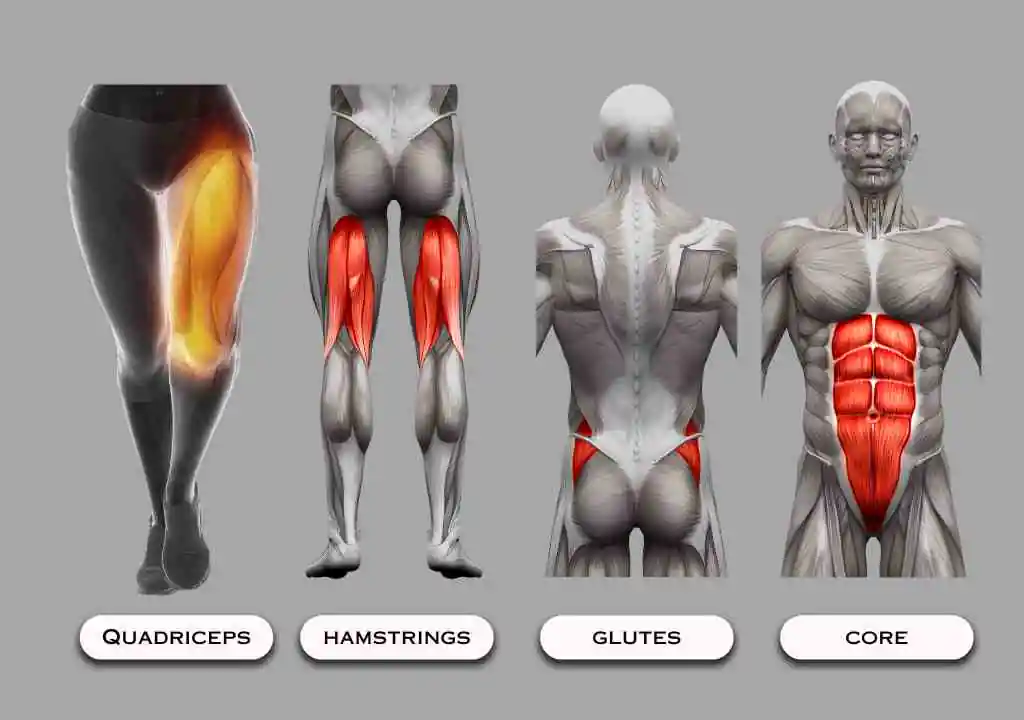Do you want to work up lower body and total strength? Well, both squats and lunges are good at doing this. But which one, however, is better for you? Know the key difference between squats and lunges, the benefits each exercise offers, and how to fit them into your workout routine.
This age-old argument continues to separate exercise buffs.
Squats target the quadriceps, hamstrings, glutes, and core, while lunges also consist of the quadriceps and hamstrings, with added glutes and calves to a lesser degree. As previously noted, both are important, and it only really gets good when you can tell which does what kind of good and how you’ll use this within your program in the name of serving your goal.
In this article, we will leave no stones unturned to make you prepared to choose the right squat for you. Let’s build a stronger lower body together.
Understanding Squats and Its Benefits
Table of Contents
After all, squats are one of the most basic compound exercises that work so many muscles all at once. This is considered among the most pivotal staples in many exercise programs because, for very good reasons, it does prove to develop strength and power.
Primary Muscle Groups

Quadriceps
The quadriceps, or quads, is a group of four muscles in the front of the thigh. These muscles are crucial in straightening the knee, which is an action involved in most daily activities such as walking, running, and climbing stairs. They are influential in giving power and holding on during exercises that work the lower body, for example, squats and lunges.
Hamstrings
The hamstrings are a group of three muscles at the back of the thigh. Their primary function is knee flexion and hip extension. They thus act to oppose the quadriceps and therefore play a vital role in balance and control processes of movement. Prevention of injury and athletic performance are built upon a base of strong hamstrings.
Glutes
One of the most powerful muscle groups in the hip area is the glutes, otherwise known as the buttocks muscles. They provide basically for hip extension, abduction, and external rotation. The glutes are the base responsible for provision of power, stability, and proper posture. Any person with strong glutes will easily walk, run, and jump in any activity that involves these actions.
Abdominal
The core is a very complicated grouping of muscles that includes the abdominals and low back muscles. Their interplay is so important because they function to provide some relative stability for the spine, pelvis, and hips. Having a strong core is important to have good posture, prevent injury, and generally enhance athletic performance. This greatly contributes to generation of power and the transference of force that is seen in dynamic movements.
Types Of Squats
Bodyweight Squats

As the name implies, the bodyweight squat is a squatting exercise performed using a person’s dead weight only as resistance. They serve as an excellent starting point for someone who has never trained for strength or wants to develop a good base for more advanced variations. Bodyweight squats assist in developing basic movement patterns, enhancing balance, and creating general strength in the lower body.
Barbell Squats
Barbell Squats are a compound exercise where a person Squats with a barbell on their shoulders. Because there’s way more resistance with it than with bodyweight squats, much strength is gained much faster. Barbell Squats are the core lift in many a workout for building strength and perhaps the best for maximal lower body power and explosiveness.
Dumbbell Squats
Dumbbell squats are executed almost the same way as barbell squats, but with each hand holding a dumbbell instead of the barbell resting on your shoulders. This version applies slightly different weight distribution than the barbell squat, which can be easier on some individuals. Dumbbell squats represent quite possibly a universal exercise, integrated into many workout routines.
Benefits of Squats:
Strength
Squats are helpful in the development of overall lower body strength. With time, difficulty, and progressive overload, this exercise is an absolute assurance of bringing in huge gains of strength and power. More of the strength achieved, however, translates into better performance in any activity, sport, or even other physical disciplines.
Power
Squats are highly explosive movements involving great power output. It is in this squat training that one develops the capacity to generate force within such a short time, and this is essential for athletes and also to other people who desire to improve their performance in activities involving power such as jumping, sprinting, or weightlifting.
Engage Core
Although squats do directly involve the muscles of the lower body, they also heavily engage the core. If anything, the proper way to squat down requires core musculature to be constantly practiced in order to not create imbalances and support the spine. Such constant practice in squatting leads to a stronger, more resilient core.
Functional Movement
Squats mirror some of the movements performed while living; sitting, getting up, and picking stuff up. In other words, when you squat, you are really working with regard to enhancing strength and competence in living movements.
You May also like to Read: Difference Between HIIT and Cardio: Can You Do Both?
Understanding Lunges and Its Benefits
The rest target the lower half. Unlike squats, lunges are unilateral such that they are single leg exercises. They are therefore suitable for bringing a balance in strength between the two legs, hence an incredible way to improve balance.
Primary Muscle Groups of Lunges
Quadriceps
The quadriceps, or quads, are really the first and foremost muscles exercised in lunges. Located at the front of the thigh, they are responsible for extending the knee. As you step forward and bend down to assume a lunging position, the quadriceps in your front leg contract to raise you up again.
Hamstrings
Lunges also significantly involve the hamstrings at the back of the thigh. During the lowering phase of the lunge, the hamstrings at the back leg do a great job in controlling the descent. They help in the climb-up phase, too.
Glutes
Lunges primarily work the glutes or buttocks muscles; however, in order to maintain balance and stability while performing this exercise, the gluteus medius is also engaged. The gluteus maximus helps in powering the movement upward when conducting a lunge.
Core
While not the primary focus of lunges, the core muscles are integral in keeping balance and stability throughout the exercise. It is the combination of abdominal and lower-back muscles that avoids rotation of the torso and helps to keep you in proper form.
Note that lunges are a unilateral exercise—meaning that they work each leg independently. This can be especially useful for identifying and correcting muscle imbalances between the legs.
Types of lunges:
Lunges are an all-round exercise that involves various muscle groups in the lower body. There exist several variations to engage different muscle groups and promote general strength and stability in the lower body.
Forward Lunges
As the name indicates, this involves stepping forward with one leg. This basic variation of lunge chiefly targets the quadriceps, hamstrings, and glutes of the front leg.
How to Perform Forward Lunges:
- Stand with your feet at shoulder width apart.
- Step forward with a leg and lower your body till both knees are bent at a 90-degree angle.
- Keep front knee over the toes and make sure the back one doesn’t touch the floor.
- Push off with the front foot to return to standing while repeating on the other leg.
Reverse Lunges
In contrast to normal lunges, which involve stepping forward, reverse lunges are conducted by stepping backward. While performing this variation, it puts a little more focus on the hamstrings and glutes.
How to Perform Reverse Lunges:
- Stand with feet at shoulder-width apart.
- Step back with one leg and make your body drop until both of your knees are at a 90-degree angle.
- Be sure to not let your front knee extend beyond your toes or your back knee to touch the ground.
- Push off with your front foot back to the starting position, then repeat with another leg.
Lateral Lunges
It activates inner and outer thighs, plus hip adductors and abductors. This exercise provides an increase in hip flexibility.
How to Perform Lateral Lunges:
- Stand with the feet at shoulder-width.
- Take a sideward stride with one leg and lower down, bending your knee, until your thigh is parallel to the floor.
- Keep your upper body upright and the other leg extended.
- Press with the outside foot to return to a standing position and then do the same with the opposite leg.
Benefits of Lunges in Improving Balance and Coordination
Lunges have several advantages besides working the muscles of the lower body. They are especially useful in enhancing balance, coordination, and general stability in the lower body.
Engagement of Core
The lunges also engage the core musculature to assist in balance and preventing rotation of the torso. This exercise makes the core stronger and enhances stability of the entire body.
Lower Extremity Stability
Regular performance of lunges provides enhanced capacity to balance and stand on one leg. With enhanced lower extremity stability, the risk of falling and injury is reduced.
Injury Prevention
This makes the leg and core muscles very strong, thus protecting joints from injuries and diseases, mainly in sporting activities that require dynamic movements.
Training with the different varieties of lunges helps one keep most of the muscle groups in good shape and even improves balance and coordination, hence reducing the potential for injury.
You May Also Like to Read: How to Get Rid of Love Handles In 2 Weeks
Squats vs. Lunges: A Detailed Comparison
Squats and lunges are two of the stone-building exercises when one wants to build both strength and development in the lower body. While they share some similarities, they also have some distinct characteristics that make them valuable in different ways.
Muscle Activation
- Squats: Sometimes referred to as the “king of exercises,” squats hit a large proportion of the muscles in your body, such as the quadriceps, hamstrings, glutes, and even the core and some upper body stabilizers. This is a compound movement that works several muscle groups at one time, making it really efficient for developing general lower body strength.
- Lunges: This exercise still places the greatest emphasis on working out the quadriceps, hamstrings, and glutes, though to a great extent it incorporates much more balance and stability because it is unilateral. Further, lunges will help the core engage in the maintenance of balance. Moreover according to research study, lunge variations can differentially activate muscles based on leg position and balance requirements.
Strength, Balance, and Muscle Definition
- Strength: Both Squats and Lunges work to give overall strength to the lower body, but generally, squats will produce more raw strength because heavier weights are used.
- Balance: The lunges are obviously far better at building up balance and stability by putting the weight of the body on one leg and challenging its ability to retain its equilibrium. Squats also contribute to good balance but not as much as Lunges.
- Muscle Definition: Both exercises can work toward muscle definition, though lunges are likely to provide a bit more specific isolation of fibers in certain muscles, such as the outer thigh, due to the unilateral nature of the movement.
Key Difference Between Squats and Lunges
- Joint involvement: Squats are a bilateral movement action whereby a person engages both legs simultaneously. Lunges are unilateral, where the exerciser trains one leg at any given time.
- Range of motion: Generally, squats provide a better range of motion to the lower body, which can result in increased muscle stimulation. Lunges have a somewhat shorter ROM but add balance and stability training.
- Muscle emphasis: While both exercises emphasize the quadriceps, hamstrings, and glutes, the lunges really get into the muscles of the working leg, and squats more equally distribute the load between the two legs.
In essence, squats and lunges complement each other; therefore, the ultimate lower body workout should involve both. Squats are perfect for gaining overall strength and power, while Lunges excel in developing balance, stability, and muscle isolation.
Incorporating Squats and Lunges into Your Workout
To maximize benefits you will want to have a well-balanced workout that makes you include your squats and lunges. Here are a few ideas:
Workout Routine Sample 1: Lower Body Focus
- Bodyweight squats: 3 sets of 12-15 reps
- Lunges (forward, reverse, lateral): 3 sets of 10-12 reps per leg
- Calf raises: 3 sets of 15-20 reps
Sample Program 2: Full Body Strength
- Squats: 3 sets of 8-12 reps
- Lunges: 3 sets of 10-12 reps per leg
- Push-ups: 3 set to failure
- Rows: 3 sets of 12-15 reps
Progression and Increasing Difficulty: Intensification of Load or Challenge
- Add weight: Start with baby steps to add weight to squats and lunges so that.
- Increase reps with all forms: Progress your reps as you are gaining endurance.
- Variety: For variations and to prevent plateaus, keep some different forms of squats and lunges in your routine.
- Plyos: To up the intensity of the workout, some other options besides the simple one are jump squats and lunge jumps.
Good Form and Technique
- Proper Posture: Back straight, core tight, knees aligned with the toes.
- Full Range of Movement: Lower your body as low as you comfortably can.
- Focus on controlled movements: Avoid bouncing or jerky motions.
Knowing the difference between squats and lunges is one of the major factor towards maximizing workouts on the lower body. While both exercises are outstanding at building power and tone, they outperform in other areas.
Squats are compound movements aimed at many muscular groups, with an emphasis put on overall power and strength. Lunges will focus more on unilateral strength, balance, and stability. This brings together the two exercises into your workout to give you a comprehensive lower body development program and will help in improving muscle balance and functional fitness.
Remember to always listen to your body, progress overload gradually, and seek advice from a healthcare expert when necessary.



